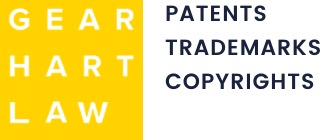Building an app is a significant accomplishment. But once it’s live—or even before—it’s natural to wonder: what parts of this thing can actually be protected? Can someone just copy your idea, tweak it slightly, and call it their own?
The answer isn’t always simple. The U.S. Patent and Trademark Office (USPTO) has strict standards when it comes to software patents, especially for mobile apps. But that doesn’t mean you’re out of options. At Gearhart Law, we help you figure out what can be protected—and how to do it right.
What Can Be Protected in an App?
When it comes to patent protection, not every part of your app will qualify. That’s because patents are meant to protect processes, methods, and systems—not just ideas or appearances. The good news is that many apps include features that fit those categories.
Here are a few things we look for when evaluating what’s protectable:
- Technical processes: If your app includes a method for processing data in a unique way, that could form the basis for a patent claim.
- Functional innovations: Features that solve a technical problem, like reducing data load, improving speed, or integrating with hardware, are stronger candidates for protection.
- Inventive user interactions: If your interface does more than just display data and involves a functional improvement (such as a new way of securing transactions or managing user input), it may be worth claiming.
The trick is making sure these elements go beyond what’s already out there. We help you frame those features in terms that the USPTO can work with—something many developers struggle to do on their own.
What Usually Gets Rejected
Some ideas just don’t make the cut with the USPTO. That doesn’t mean your app isn’t valuable—it just means certain features aren’t eligible for patent protection.
Here’s what typically gets rejected:
- Abstract concepts: Broad ideas like “organizing contacts” or “matching users based on preferences” without a technical twist are unlikely to succeed.
- Generic visuals: Standard layouts or drag-and-drop menus don’t usually offer enough innovation.
- Business methods: If your app just replicates a business process without a new technical solution, it may fall flat with examiners.
These elements might still be important to your product. But if they can’t be patented, we help you find other ways to protect them or identify features that can strengthen a patent filing.
How a Patent Attorney Can Help You Frame Your App’s Innovation
You might know your app inside and out, but writing a patent application isn’t just about describing what it does. It’s about shaping that description in a way that shows technical value and meets legal requirements.
That’s where we come in.
We work with you to:
- Identify features with patent potential
- Break down how those features work under the hood
- Write claims that emphasize technical improvements, not just functionality
- Anticipate what a patent examiner might question and address it upfront
We’ve seen plenty of promising apps miss their shot at protection because the patent application didn’t highlight the right elements, or used language that was too broad or too vague. We’ll make sure yours is framed clearly and strategically.
Other Ways to Protect Your App
Not every part of your app will qualify for a patent, but that doesn’t mean it’s left unprotected. We often help clients build a layered approach to safeguard different parts of their product.
Here are a few other IP tools you should consider:
- Copyright: Protects your app’s code, visual design, and written content.
- Trademarks: Covers your app’s name, logo, and branding.
- Trade secrets: If your app includes proprietary algorithms or backend systems, keeping them confidential may be a smart move.
- Contracts: NDAs and contractor agreements can keep key information secure.
We’ll help you figure out what mix of protections makes the most sense for your app and your business goals.
Ready to Find Out What’s Patentable in Your App?
If you’re developing something new—or already launched something great—don’t wait until someone else copies it. We’ll help you sort out what’s protectable, what’s not, and what your next step should be. Contact Gearhart Law today to schedule a consultation. Let’s make sure your app gets the protection it deserves.

